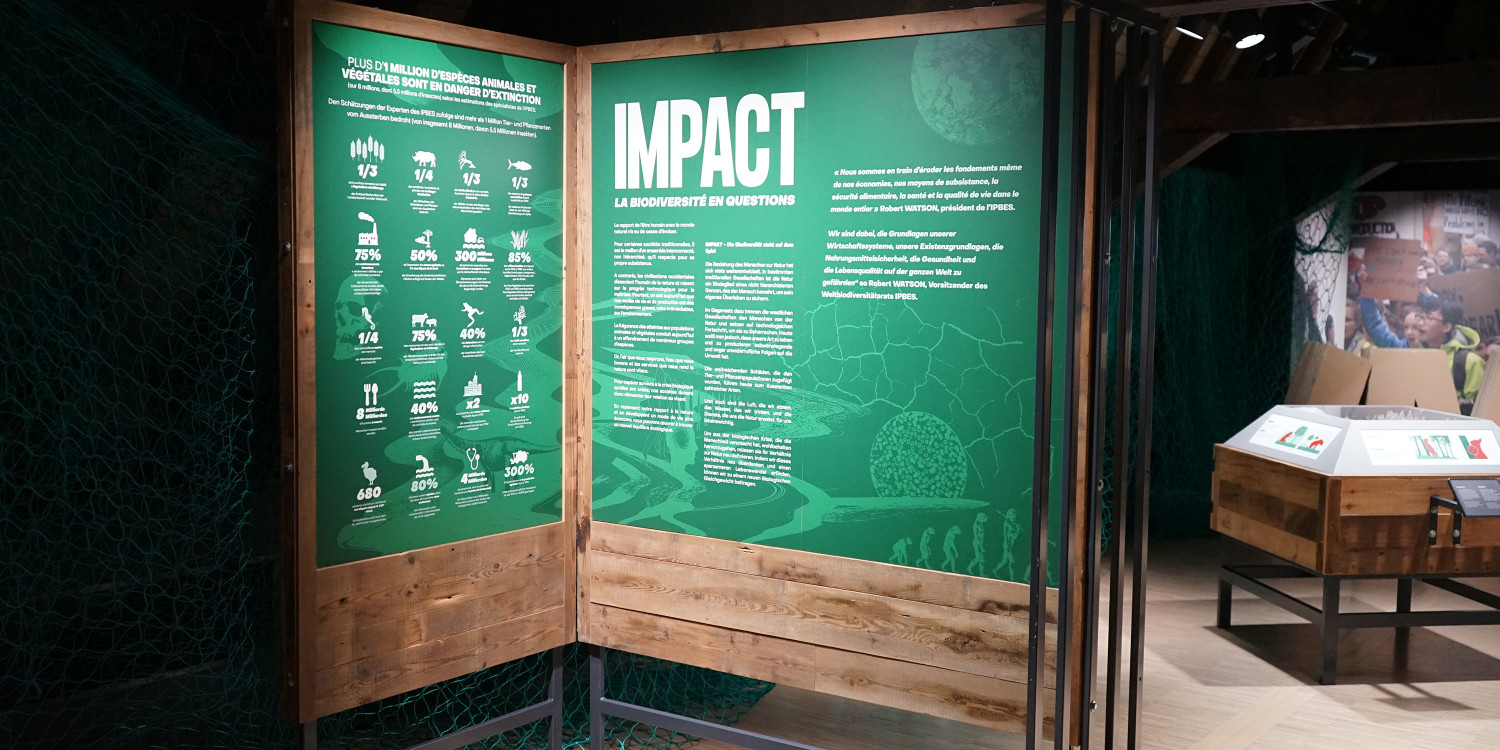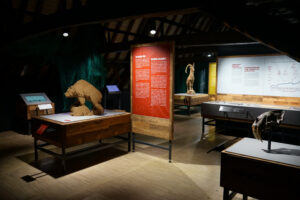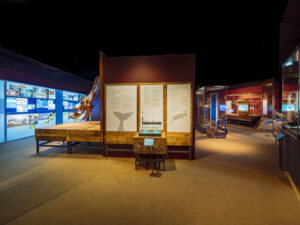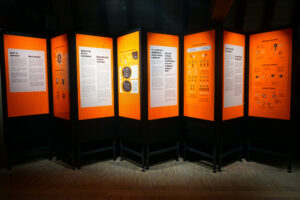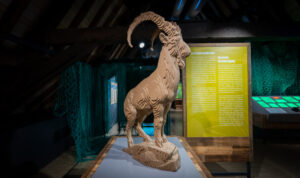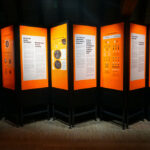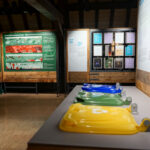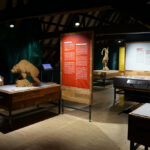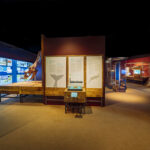“The best waste is no waste”.
Since 7 October 2022, the travelling exhibition Impact, Biodiversity Matters has been on display for the first time at the Luxembourg National Museum of Natural History. Now is the perfect time to examine the design and production processes behind the travelling exhibition from an eco-friendly and sustainability perspective.
The title of one section of the exhibition, “Biodiversity best practices: the 3 Rs: recycle, reduce, reuse”, perfectly illustrates the origins of the project. A project that wants to inform and raise awareness of biodiversity issues among its audiences, and encourage them to take action. An eco-friendly and sustainable approach, both in the themes it addresses and in its design, production and life-cycle management.
Impact, which was designed from display elements recycled from London’s Natural History Museum exhibition Extinction, Not the End of the World?, questions the evolution of biodiversity, from the birth of the Earth to potential future scenarios, by rethinking our relationship with the living world. Three major sections (Yesterday’s Worlds, Today’s World and Tomorrow’s World) presenting the main stages of the history of life have been designed to help visitors understand the current biodiversity crisis and question the impact of our consumption patterns on the planet. It broaches themes such as the place of humans in the Earth’s history, the impact of our lifestyles and demographics, but also how to respect and restore biodiversity and how to adopt better consumption habits in order to live better. The exhibition comprehensively addresses the issues surrounding biodiversity by asking thought-provoking and relevant questions.
Display elements reused
The travelling exhibition Impact, Biodiversity matters, developed by the Natural History Museum of Toulouse, is representative of a sustainable design approach. The wood used for the display elements has already been recycled; it comes from a 150-year-old cotton mill in Lancashire, north of Manchester, in England. The wide flooring there was taken apart before being reused for the first time in 2013 to serve as display elements for the exhibition Extinction, Not the End of the World? at London’s Natural History Museum. That exhibition was then turned into a touring exhibition, which travelled to China, Portugal and, in 2019, Toulouse – its final stop before returning definitively to the Extinction collections in London. Since the display elements and transportation crates were in Toulouse, the two museums seized the opportunity to give them a second, or rather, a third life, with a new travelling exhibition designed in-house by the Museum of Toulouse. The idea itself for the contents of the exhibition, which naturally questions the impact humans have on the environment, was born out of this eco-friendly approach. We’ve come full circle… or nearly; we now need to think about what happens next – touring and the eventual end of life of these display elements.
The constraints of touring
We are all aware that the travelling version of an exhibition adds numerous constraints to a traditional exhibition. Design adaptability must be considered, as well as changes in language or optimal packing and crating for the exhibition’s transportation. The Museum’s exhibition designer had to consider the exhibition’s spatial development, working from the existing displays to design a new exhibition. This had never been done before at the Natural History Museum of Toulouse.
Before exploring how to reuse the London exhibition’s design, the Natural History Museum of Toulouse firstly listed what was reusable as it was, and put aside units that were too heavy or worn. In total, 95% of the display elements were kept. The structures were then reassembled or adapted to fill gaps or integrate a screen. MDF panels were added to the most worn units, and images and words were printed on Dibond® aluminium composite panels.
Spatial adaptability was already a key aspect of the Museum’s standards for touring exhibitions. With Impact, solutions had to be sought to ensure that things were in keeping with the subject of the exhibition and the reuse of the materials from the London exhibition, including the transportation crates. The museum’s current productions are transported in flight cases designed for convenient transportation that is adaptable to the host venue: commonly used in the management of live shows, they are light and wheeled, which makes them easier to move around. Here, the existing bespoke wooden crates were intended for large-scale displays; they are heavy to move and require a dedicated team to handle them, as well as specialist equipment (forklift truck, pallet truck, hoist, etc.). The Museum experiments, tests and takes these new constraints into account. Its teams optimise the packing and crating of components and prioritise locating museums and cultural sites that are capable of receiving these crates.
Transportation is a key question in touring exhibitions. Considering transportation in an eco-friendly way is a complex issue. In addition to the carbon offset planned for each journey, the Museum aims to organise the reduced environmental impact of the touring exhibition by, as a matter of priority, identifying and communicating with potential audiences within a radius of a few hundred kilometres of the ongoing exhibition in order to make it more responsible. The Museum works first and foremost with local partners and encourages the host venue to integrate local collections and in house displays where relevant. The Museum of Luxembourg, for example – the first venue to host the exhibition – incorporated a local dimension with the overall exhibition design by adding scenic items and large screens to cover up local challenges and stories. As for adjusting to the host country’s language, the team planned the installation of new texts on magnetic panels, which could be placed on top of the existing panels. This practice, which is widely used in touring, enables a higher degree of modularity.
Recycling
The creation of an exhibition must be considered in a comprehensive manner, with the same amount of attention paid to the selection of exhibition themes and space design, as to the way in which it will be crafted and produced. The choice of building materials is crucial. As already discussed, some of the display elements for Impact come from a previous exhibition, so it simply made sense to use eco-friendly materials in the revival of these elements: Dibond®, honeycomb cardboard and eco-friendly inks.
Dibond® is an aluminium composite sheet with two aluminium cover layers and a polyethylene core, and is 100% recyclable. The aluminium cover layers are suitable for recycling because they can be recycled over and over again with no detrimental effect to their properties. The core is also reusable and can be recycled many times.
The exhibition features four animals representing extinct species: a cave bear, a dodo, a Pyrenean ibex and a Chiriquí harlequin frog. In the form of totem poles, they have place of honour at the entrance of each main section. They were designed using digital 3D cutting technology and are made from honeycomb cardboard, which is a well-known eco-friendly material: it is made out of recycled kraft paper and is 100% recyclable and biodegradable. While rather large, the statues are still light and therefore easy to transport, and can be put in place with just a few screws. The Pyrenean ibex, for example, is 1.3 metres high but only weighs 7.5 kg.
An exhibition’s end of life cycle is a subject that requires consideration prior to its final display; in fact, it requires consideration from its initial conception. To that end, the Museum is in touch with a recycling platform established in the area that strives to recycle and reclaim artistic design elements in order to integrate them in a circular economy on a wider scale. The Museum contacted this company first regarding the part of Extinction that was not re-used, and continues to approach them when other exhibitions come to the end of their life cycles. The components are either taken apart and reclaimed in the production of new furniture and design elements, or kept as they are in order to be re-used in another project, whether in a museum, cinema or theatre.
“Nothing is created, neither in the operations of art, nor in those of nature, and it may be posed in principle that in every operation there is an equal quantity of matter before and after the operation; that the quality and quantity of the principles is the same, and that there are only changes, modifications” – Lavoisier
In the words of the exhibition manager: “A touring exhibition is a living exhibition. From its creation to it running, it is evolving, changing, transforming, and can grow.” The more attention is paid to the life cycle of a travelling exhibition from the earliest stages, the more adaptable it will be to every host venue. And the more optimised the use of its component elements in the long-term, the more minimised and sustainable its impact.
A comprehensive sustainable approach
This project is in line with the overall approach of the Natural History Museum of Toulouse, which has been incorporating accessibility and sustainability principles in all of its travelling exhibitions for several years now. The interactive content and materials developed are conceived for a very wide audience, with particular attention being paid to children and schools. The Museum offers “turnkey” exhibitions that are rich in content and interaction. They are designed to be able to be adapted to reasonable and flexible budgets and sizes (they fit in one or two semi-trailers at most), allowing these projects to be shared with as far-reaching audiences as possible, with possibilities of presentations in large venues as well as being adaptable to smaller museums, which enables the development of tours in a more concentrated geographical area.
For each exhibition, in co-operation with the host partner, the Museum is committed to thinking out every exhibition component down to the finest details so as to promote the most positive footprint: collections only where necessary, integration of local collections, eco-planned museum exhibits, digital simplicity and a wide range of low-tech educational interactives.
Exhibition mentioned
Impact, biodiversity matters, by Museum d’Histoire Naturelle de Toulouse

